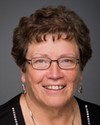Thank you so much, Madam Chair and members of the committee.
I'm very pleased to be here with you.
My name is Marla Israel. I am the director general, acting--this is day seven for me on the job--for the Centre for Health Promotion at the Public Health Agency of Canada, and Cathy Bennett is acting director. We're going to tag team between the two of us to answer your questions today.
I am very pleased to be here to discuss an issue that has received increased attention in recent years and one that will likely continue to gain greater attention as the number of Canadian seniors continues to rise.
I know you'll agree that abuse in any form is unacceptable in Canadian society, particularly abuse against older women, who, due to age, disability, income status or family situations, are the most vulnerable. Sadly, the abuse of older adults remains somewhat of a hidden social problem that affects the lives of many seniors. Victims of abuse and their families experience intangible social costs that include adverse health consequences that can undermine or destroy an individual's well-being.
Clearly, there is a strong role for the Public Health Agency to play in addressing elder abuse. We work towards promotion of better health outcomes for all populations, but in particular for the most vulnerable.
Society may not be fully aware of the vulnerabilities that affect different segments of the population, but seniors, in particular, are vulnerable to emotional and physical abuse, especially given the physical effects of weakening health or disease and the challenges associated with placement in an institutional setting.
The definition that the Public Health Agency employs to define elder abuse comes from the World Health Organization: "a single or repeated act, or lack of appropriate action, occurring within any relationship where there is an expectation of trust which causes harm or distress to an older person".
Elder abuse takes many forms. It can be physical, psychological, financial, and neglect. It is somewhat difficult to know the full extent of this problem in Canada, since the data is somewhat under-reported. But data obtained from Statistics Canada indicates that approximately 8% of seniors were victims of abuse between 1994 and 1999.
When this percentage is applied to the current population, it's estimated that as many as 300,000 seniors are victims of abuse.
It has been also been estimated that only one in five incidents of elder abuse may come to the attention of those who can help. Of particular interest to this standing committee, it is estimated that four out of ten older adult women who were victims of violence were victimized by a member of their own family.
Actions may include pushing, slapping, and threatening to apply force. Even more disturbing is that among solved homicides between 1994 and 2003, more than two-thirds of older adult women were killed by a family member.
The challenges of addressing elder abuse are compounded by rapidly changing demographics. So while the rates of elder abuse may not change, the absolute numbers of seniors affected by abuse definitely will.
The Government of Canada is committed to addressing these pressing and complex issues, and has done so for several years through the Family Violence Initiative and more recently through the Federal Elder Abuse Initiative.
The Family Violence Initiative is led and coordinated by the Public Health Agency of Canada. Through the initiative, targeted investments and the collaborative efforts of 15 federal departments, agencies and crown corporations are leveraged in an effort to bring greater attention to the issue of family violence in Canada. The leadership and coordination role of PHAC focuses largely on:
Federal-provincial-territorial coordination, to ensure that the policy approach to family violence is shared and that we are not working at cross-purposes. For example, through collaboration with Status of Women Canada, we developed a policy brief entitled Engaging Men and Boys to Reduce and Prevent Gender-Based Violence.
This brief examined historical efforts to address violence, the deep-rooted causes that may precipitate men to be more violent, identified gaps and challenges and shared best practices that could be considered in program development at the provincial and territorial level.
Secondly, through the National Clearinghouse on Family Violence, the Public Health Agency of Canada plays the role of knowledge broker on behalf of the partners to health and social service providers, the general public, academia, and NGOs.
And thirdly, through data collection, research, and evaluation the Public Health Agency of Canada is better able to support policy-to-practice efforts.
In 2006 the federal government created the National Seniors Council, and in so doing began to address the complex issue of elder abuse in more detail. I understand that the NSC will be testifying later on, so I will defer any detailed descriptions to that body. But in 2008 the federal government launched the federal elder abuse initiative, a three-year, $13 million initiative to raise awareness of elder abuse among seniors, their families, and key professional groups, and to develop resources and tools to support them in responding to elder abuse.
Our public health action relied upon scientific evidence to identify the risk factors for elder abuse in order to determine which interventions work best to prevent that abuse or reduce its impact.
As I mentioned earlier, reliable information on elder abuse was limited. Part of the problem lay in the need to develop better guidance and information for public health professionals to recognize the emerging signs of abuse. For medical professionals, tracking abuse statistics begins with recording the tell-tale signs of abuse, and making a determination that abuse exists in the first place.
As a result, the Public Health Agency examined the quality and availability of resources available to physicians and other medical professionals to identify and respond to the suspicion of elder abuse and improve the guidance available to practitioners. I should say that work is still in progress, and we can address that. A lesson learned through this exercise is that solid clinical knowledge is a prerequisite for good screening and assessment. Similar work was done in first nations communities. The conclusion was the development and adaptation of learning tools and resources for first nations community health workers.
The Public Health Agency also developed other knowledge tools and resources for front-line professionals such as pharmacists and social workers, who deal with and support seniors on a daily basis. As well, the agency examined other facets of elder abuse in more detail. For example, we looked at elder abuse through the lens of gender-based analysis. This perspective recognizes that treating women and men identically may be beneficial in some ways, but ineffective in other ways. For example, compared to older women, older men were more reluctant to go for help; outreach interventions provided at home on their own turf are particularly effective for them.
The federal elder abuse initiative ended in March 2011; however, we continue to focus on preventing elder abuse as part of our work to foster inclusive, accessible, age-friendly communities. Many communities are improving the information they provide to seniors about available community support services--for example, access to transportation for medical appointments.
In closing, the devastating impact of elder abuse on our older Canadians cannot be overstated. It needs continued action from all sectors of government and society as a whole. As a result of our collective efforts we have a better understanding of the tools needed for health professionals to be better equipped to identify, assess, and take action on elder abuse.
There is also a need to have current and comprehensive data on elder abuse, particularly for older women. Good and reliable data is the foundation for developing strong public health policy and program directions that support seniors' health and well-being.
Thank you so much for your attention. We would be pleased to answer any questions you have.










